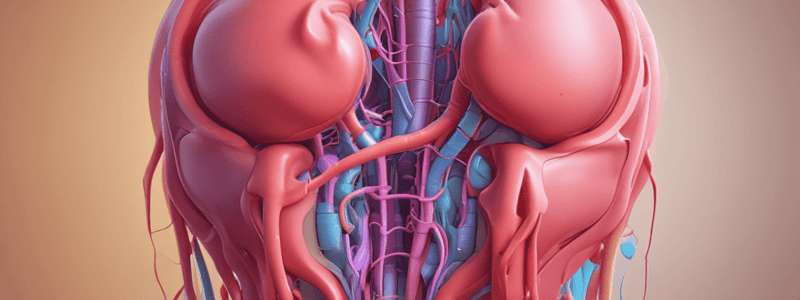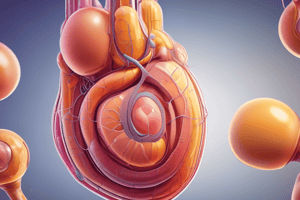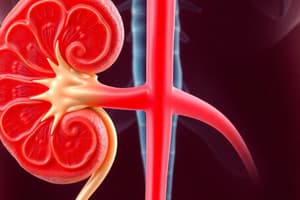Podcast
Questions and Answers
What are the components of the urinary system?
What are the components of the urinary system?
- Two kidneys, one ureter, one urinary bladder, and one urethra
- One kidney, two ureters, two urinary bladders, and one urethra
- Two kidneys, two ureters, one urinary bladder, and one urethra (correct)
- Two kidneys, two ureters, two urinary bladders, and two urethras
What happens to the water and solutes after the kidneys filter blood plasma?
What happens to the water and solutes after the kidneys filter blood plasma?
- Returned to the bloodstream (correct)
- Stored in the bladder
- Excreted as urine
- Converted to red blood cells
Which hormone regulates erythrocyte production in response to kidney function?
Which hormone regulates erythrocyte production in response to kidney function?
- Adrenaline
- Erythropoietin (EPO) (correct)
- Thyroxine
- Insulin
Where does the regulation of ion levels such as sodium and potassium take place?
Where does the regulation of ion levels such as sodium and potassium take place?
What is the collective term for the urethra, ureters, and urinary bladder?
What is the collective term for the urethra, ureters, and urinary bladder?
Where are the kidneys located in the body?
Where are the kidneys located in the body?
Which part of the urinary system is responsible for storing urine?
Which part of the urinary system is responsible for storing urine?
What is the primary function of the urethra in the urinary system?
What is the primary function of the urethra in the urinary system?
Which of the following statements about the urinary system is correct?
Which of the following statements about the urinary system is correct?
What is the innermost protective layer of the kidney called?
What is the innermost protective layer of the kidney called?
Which region of the kidney contains the nephrons?
Which region of the kidney contains the nephrons?
What structure in the kidney allows the passage of renal artery, vein, lymphatic vessels, and nerves?
What structure in the kidney allows the passage of renal artery, vein, lymphatic vessels, and nerves?
Where do 1 million nephrons reside in the kidney?
Where do 1 million nephrons reside in the kidney?
Which structure passes through the renal medulla of the kidney?
Which structure passes through the renal medulla of the kidney?
What part of the renal tubules lies close to the nephron and collects urine?
What part of the renal tubules lies close to the nephron and collects urine?
What is the structure that divides the renal columns in the kidney?
What is the structure that divides the renal columns in the kidney?
Which structure collects urine and drains into the ureter in the kidney?
Which structure collects urine and drains into the ureter in the kidney?
Where does reabsorption occur in the kidney?
Where does reabsorption occur in the kidney?
What is the role of the visceral layer of glomerular capsule?
What is the role of the visceral layer of glomerular capsule?
What are podocytes?
What are podocytes?
Which process involves water and some dissolved solutes moving out of the glomerulus and into the capsular space?
Which process involves water and some dissolved solutes moving out of the glomerulus and into the capsular space?
What happens once fluid leaves plasma and enters the capsular space?
What happens once fluid leaves plasma and enters the capsular space?
What is the function of tubular reabsorption in urine formation?
What is the function of tubular reabsorption in urine formation?
Which component is part of the urinary tract?
Which component is part of the urinary tract?
What are the three basic processes performed by nephrons in urine formation?
What are the three basic processes performed by nephrons in urine formation?
What are the two distinct regions of the kidney based on internal anatomy?
What are the two distinct regions of the kidney based on internal anatomy?
In the kidney, what do the renal columns do?
In the kidney, what do the renal columns do?
Which part of the kidney is referred to as the tip of a renal pyramid?
Which part of the kidney is referred to as the tip of a renal pyramid?
What structure collects urine and transports it into the ureter?
What structure collects urine and transports it into the ureter?
How many renal lobes does a typical kidney have?
How many renal lobes does a typical kidney have?
Which blood vessel delivers blood directly to the glomerulus in the kidney?
Which blood vessel delivers blood directly to the glomerulus in the kidney?
What is the primary function of the kidney?
What is the primary function of the kidney?
What is the function of the urinary system?
What is the function of the urinary system?
Where is the opening of the urethra located in females?
Where is the opening of the urethra located in females?
Which part of the male urethra is lined by pseudostratified epithelium proximally and stratified squamous distally?
Which part of the male urethra is lined by pseudostratified epithelium proximally and stratified squamous distally?
Which type of epithelium lines the prostatic urethra in males?
Which type of epithelium lines the prostatic urethra in males?
Which region does the male urethra pass through first before reaching the penis?
Which region does the male urethra pass through first before reaching the penis?
What is the main difference between the male and female urethras?
What is the main difference between the male and female urethras?
Flashcards are hidden until you start studying
Study Notes
Kidney Structure and Location
- Kidneys are located behind the abdominal wall and are retroperitoneal.
- The renal capsule is the innermost protective layer of the kidney.
- The layer that protects the kidneys from trauma and holds them firmly in place is the renal capsule.
- The renal cortex is the region of the kidney that contains nephrons.
- The renal hilum is the structure through which the renal artery, vein, lymphatic vessels, and nerves pass.
- The renal cortex has approximately 1 million nephrons.
- Renal pyramids are structures that pass through the renal medulla of the kidney.
Nephron Function
- A nephron receives blood through the afferent arteriole.
- The efferent arteriole carries blood away from the nephron.
- The collecting duct is part of the renal tubules that lies close to the nephron and collects urine.
- The renal pyramids divide the renal columns.
Urinary Tract
- The urinary tract is composed of the ureters, urinary bladder, and urethra.
- The urinary bladder collects urine and drains into the ureter.
- The trigone is the area of the bladder where the ureters open.
Urinary System Functions
- The urinary system filters waste products from the blood and converts it to urine.
- The system regulates blood volume, erythrocyte production, ion levels, and acid-base balance.
- The urethra transports urine from the urinary bladder and expels it outside the body.
Kidney Functions
- The kidneys filter blood plasma and return most of the water and solutes to the bloodstream.
- The kidneys regulate blood volume, erythrocyte production, ion levels, and acid-base balance.
- Erythropoietin acts on stem cells in the bone marrow to increase erythrocyte production.
Urine Formation
- Nephrons form urine through three processes: glomerular filtration, tubular reabsorption, and tubular secretion.
- Glomerular filtration occurs when water and dissolved solutes move out of the glomerulus and into the capsular space of the renal corpuscle.
- Tubular reabsorption occurs when substances in the filtrate return to the blood.
- Tubular secretion occurs when solutes are actively transported out of the blood and into the tubular fluid.
Studying That Suits You
Use AI to generate personalized quizzes and flashcards to suit your learning preferences.




